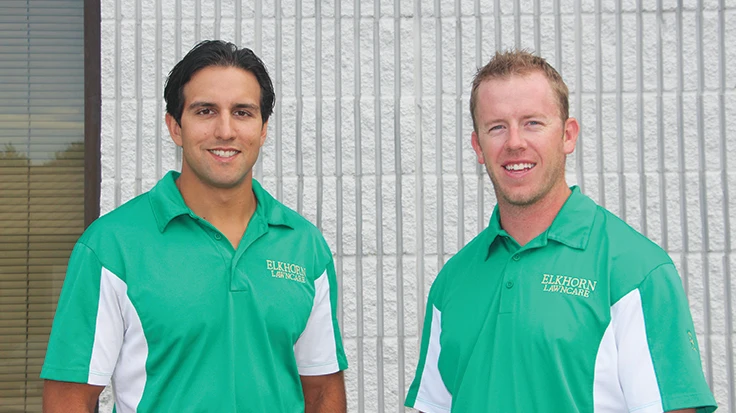
 Having the right employee incentives and some technology to aid in snow removal can make offering this service a little less arduous, says James Manske, co-owner of Elkhorn Lawn Care.
Having the right employee incentives and some technology to aid in snow removal can make offering this service a little less arduous, says James Manske, co-owner of Elkhorn Lawn Care.
The company was founded in 2007 and a snow removal service was added a year later to help keep business steady year-round. Today, the company strives to have every client on the books use both their landscape and snow removal service.
Clients at Elkhorn Lawn Care are residential, commercial and government agencies. The office’s hub is in Omaha, Neb., with about 18 year-round employees. They also work with hourly subcontractors in Iowa, Missouri, Kansas and Utah during the green season.
Revenue at Elkhorn Lawn Care is about $1.5 million annually and the snow removal service accounts for about $80,000 to $90,000 of that revenue.
In the beginning, snow removal was done on about 40 properties. Last season, snow was removed on 45 commercial properties, at 11 government facilities and at more than 150 residential properties.
Prepping for the season.
Ideally, snow removal service begins in November and runs through March to early April in Nebraska.
More recently, temperatures in November and December were in the 40s and 50s. Snowfall didn’t begin until the end of December. This makes preparing for the season a bit of a challenge.
“We pretty much know what each truck can handle a day, or can take on for an average snow storm, so we plan it that way and then just depending on if we get more contracts, we get more trucks, more equipment,” he says. Manske owns seven trucks, and each of his 13 subs owns two.
Employees are given advance notice of when they may be needed for a snow emergency. If the forecasted snow doesn’t pan out, a phone tree is used to notify crews that they will not be needed.
Driving sales via the web
Today, more than ever, Elkhorn Lawn Care’s web presence is a driving referral source. So much so that the company re-launched its site in June with an enhanced focus on search engine optimization and mobile-responsiveness, says James Manske, co-owner.
“We’ve gotten a lot of new business from it,” he says. “It’s been a huge help.”
An updated bill-paying link allows clients to pay invoices by credit card and to download receipts.
“It just saves numerous hours of paying over the phone or transferring money from PayPal,” Manske says. “It clears up the phones for our office manager that otherwise was just taking people’s payments all day.”
The website was launched in partnership with an outside web developer.
“We don’t even advertise outside of online anymore,” he says. “Nobody has time to look and say, ‘Oh, where was that sheet I got in the door in the spring?’ So, we stopped even doing normal marketing. We've gotten more responses by updating the website SEO than we probably ever would from flyers and newsletters.”
The website also has an option where clients can request a quote any time of day or night – whatever is convenient for them. If an inquiry comes in after hours, an employee at Elkhorn Lawn Care will reply to it first thing the next business day, he says.
Elkhorn Lawn Care uses Google Analytics to monitor web traffic. From March to July 2014, the company’s website saw 5,651 pageviews from 1,059 users.
During the same time period a year later, following the website relaunch, elkhornlawncare.com received 13,489 pageviews from 3,723 users.
In preparation for the season, all equipment is brought out, tuned up and serviced in late October or early November. All snow removal routes are updated to include new clients. Past clients are contacted to let them know service will be continued unless they prefer otherwise.
“Everybody knows what they're doing already, and then we usually have a meeting in November (to discuss) who is doing what this year and what routes everybody’s taking. Then usually we don’t have another meeting until the day before, or the night of, or the day that it’s snowing. Just to kind of refresh,” Manske says.
Employee management.
Snow removal work is demanding, and because of that, hourly employees are paid more during the winter season. For salaried employees this is already built into their pay, Manske says.
Those working holidays receive bonuses beyond their normal rates. An hourly employee may normally make $12 per hour, but during holidays they can make $20 to $28 per hour. Keeping equipment maintained and running is critical so that employees are not fighting the elements on top of faulty or ill-running machines.
“By having equipment that works all the time, trucks that work all the time, plows that work, help them get their job done quicker,” Manske says.
Each plow crew is made up of two to three people. One is a foreman who usually operates the plow itself. Others do shoveling, snow blowing and salting of sidewalks, he adds.
Organizing routes.
Snow removal routes are organized by tier. The highest-traffic locations, such as fast food restaurants, offices, strip malls and medical buildings are cleared first. Then crews work medium-traffic locations such as stores or businesses with limited hours. Low-traffic locations include residential properties, storage facilities or properties with few employees.
Most clients pay per removal, because of the unpredictable weather in Omaha.
“It’s so iffy if it’s going to be an intense year or not, and it’s just a lot easier to bill for work done,” Manske says.
Saving time online. Technology continues to play a huge role helping the estimating process for both snow removal and landscape work, Manske says. Properties, including sidewalks and driveways, can be measured online.
“We have an exact price per square footage of plowing and salting for our customers, and then we get those (estimates) out to them instantly also,” Manske says.
The company’s office manager usually handles these estimates from the comfort and convenience of an office.
“If you think about just driving to each location, it takes 15 minutes minimum to get there, 15 minutes back, plus just looking around,” he says. “I’d say hundreds of hours (are saved) a year.”
The author is a freelance writer based in Cleveland.

Explore the September 2015 Issue
Check out more from this issue and find your next story to read.
Latest from Lawn & Landscape
- Connect, Control & Conserve with Horizon Technical Services
- Use Horizon's Parts Hotline
- How I built a Top 100 company
- Horizon’s Exclusive TurfGro Fertilizer
- Grow your business with mosquito control
- LandCare adds 2 branches in SoCal, promotes Aleman to branch manager
- Spray them away
- PERC helps debut propane direct-injection fuel system at ACT Expo 2025





